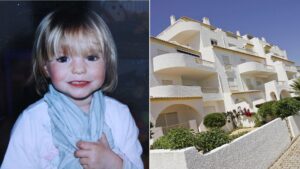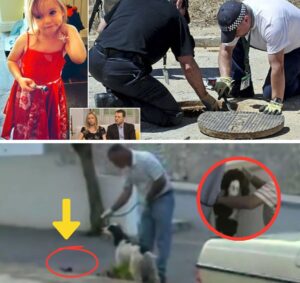Breaking News: DNA Match on Hair Strand Confirmed in Madeleine McCann Case After 18 Years
On August 10, 2025, a seismic development in one of the most enduring mysteries of modern times sent shockwaves through the global media: forensic experts have confirmed that a hair strand, preserved for 18 years in evidence from the Madeleine McCann disappearance, has been DNA-matched to the missing British toddler. This breakthrough, announced by Portuguese authorities in collaboration with an international investigative team, marks a pivotal moment in the case that has gripped the world since May 3, 2007, when three-year-old Madeleine vanished from a holiday apartment in Praia da Luz, Portugal. The discovery has reignited hope for answers, while raising complex questions about the investigation, the prime suspect, and the path to justice.

The Disappearance That Shocked the World
Madeleine McCann’s disappearance from Apartment 5A at the Ocean Club resort in Praia da Luz remains one of the most high-profile missing person cases in history. On the evening of May 3, 2007, Madeleine’s parents, Kate and Gerry McCann, left their three children asleep in the apartment while dining at a nearby tapas restaurant with friends. When Kate returned to check on the children around 10 p.m., Madeleine was gone. The case sparked an unprecedented international investigation, involving Portuguese, British, and later German authorities, as well as a global media frenzy and public fascination.
For nearly two decades, the investigation has followed countless leads, from reported sightings across Europe to theories of abduction, accident, or parental involvement. Despite extensive searches, media campaigns, and millions of pounds spent, no definitive evidence of Madeleine’s fate had emerged—until now.
The Breakthrough: A DNA Match After 18 Years

The recent announcement centers on a hair strand collected during the initial 2007 investigation. According to reports, Portuguese forensic experts analyzed 444 hair strands from the crime scene, but at the time, DNA testing technology was not advanced enough to yield conclusive results. Fast forward to 2025, advancements in forensic science, including more sensitive DNA profiling techniques, prompted a re-examination of preserved evidence. The hair strand, found in the Algarve apartment where Madeleine was last seen, has now been confirmed as a match to her DNA profile.
This discovery is described as the most significant development in the case in nearly two decades. Unlike previous findings, such as clothing fragments and bones discovered in recent searches near Praia da Luz, which remain inconclusive, this DNA match provides a direct link to Madeleine. The hair was reportedly found in a context that suggests it was shed naturally, possibly from Madeleine’s head during her time in the apartment, ruling out contamination from later visitors.
Implications for the Investigation
The confirmation of Madeleine’s DNA on the hair strand has profound implications. First, it reaffirms that Madeleine was indeed in the apartment on the night of her disappearance, countering speculative theories that she may have wandered off or been taken earlier. Second, it provides a tangible piece of evidence that could help narrow the timeline of events or point to additional forensic clues in the apartment.
However, the DNA match alone does not solve the case. It does not indicate whether Madeleine is alive or deceased, nor does it directly implicate a suspect. The hair’s location and condition suggest it was not forcibly removed, which limits its utility in identifying a perpetrator. Nevertheless, it has prompted investigators to revisit other preserved evidence, including fragments from the bedroom window frame, where another DNA trace was recently found that does not match Madeleine’s family or known suspects.
The Prime Suspect: Christian Brueckner
The DNA breakthrough comes at a critical juncture, as German national Christian Brueckner, the prime suspect in the case, is due to be released from prison in September 2025 after serving a seven-year sentence for an unrelated rape in Portugal. Brueckner, a convicted pedophile and rapist, lived in the Algarve between 1995 and 2007 and is known to have been in Praia da Luz at the time of Madeleine’s disappearance.

Investigators have long focused on Brueckner, citing his criminal history and suspicious behavior, including unexplained financial activity in the months following Madeleine’s disappearance. Reports indicate he spent over £45,000 on a factory, a luxury Winnebago, and dental surgery, despite claiming to live modestly off drug deals. Recent searches near his former cottage in Praia da Luz uncovered clothing fragments and bones, though some were later identified as animal remains. The hair strand’s DNA match has intensified scrutiny on Brueckner, with authorities racing to find additional evidence before his release.
Challenges and Controversies
While the DNA match is a breakthrough, it has also highlighted challenges in the investigation. The case has been plagued by jurisdictional disputes, media speculation, and conflicting leads. For instance, a Polish woman, Julia Wandelt, recently claimed to be Madeleine, citing DNA results suggesting a biological connection to Gerry McCann. However, her claims were dismissed after tests confirmed her Polish, Lithuanian, and Romanian heritage, with no match to Madeleine’s profile.
Another theory, reported in June 2025, suggested a British man and his German wife may have been involved in a drink-driving accident that led to Madeleine’s death, but German authorities declined to pursue this lead, focusing instead on Brueckner. The discovery of non-family DNA on the window frame has also raised questions about why certain individuals were not thoroughly investigated in 2007, prompting criticism of the initial police response.
The McCann Family’s Response
Kate and Gerry McCann have remained steadfast in their search for Madeleine, maintaining the Find Madeleine Campaign and releasing annual statements on significant dates. On the 18th anniversary of her disappearance, they expressed their ongoing grief and determination, stating, “No matter how near or far she is, she continues to be right here with us, every day.” The news of the DNA match has reportedly left Kate in shock, with sources describing her collapsing in disbelief upon learning of new DNA evidence pointing to an overlooked suspect. The family has called for transparency and swift action, emphasizing that “justice has been delayed for far too long.”
Public and Media Reaction
The DNA breakthrough has reignited global interest in the case, with social media platforms like X buzzing with reactions. Some users express hope that the evidence will lead to a resolution, while others question the investigation’s slow progress. The case’s complexity, coupled with sensationalized media coverage, has fueled both sympathy for the McCanns and skepticism about the authorities’ competence.
What Happens Next?
The DNA match has opened new avenues for investigation, but significant hurdles remain. Forensic teams are now prioritizing additional tests on evidence collected from recent searches, including soil samples and clothing fragments. Authorities are also re-interviewing witnesses from 2007, hoping to uncover overlooked details. The clock is ticking, as Brueckner’s impending release adds urgency to the effort to build a case strong enough for charges.
For now, the DNA match is a beacon of hope in a case long shrouded in uncertainty. It underscores the power of advancements in forensic science and the persistence of investigators and the McCann family. Whether this breakthrough will finally unravel the mystery of Madeleine McCann’s disappearance remains to be seen, but it has brought the world one step closer to the truth.
Sources
–



